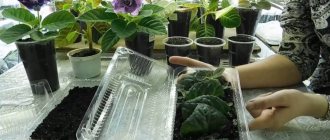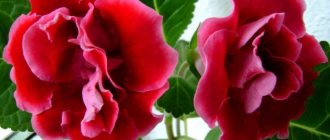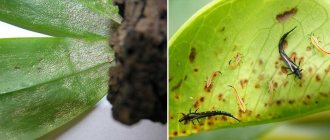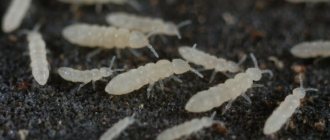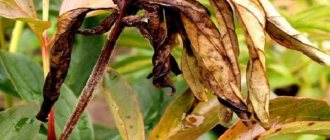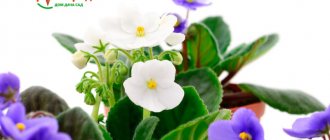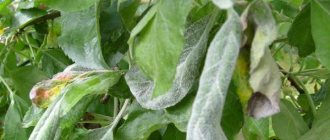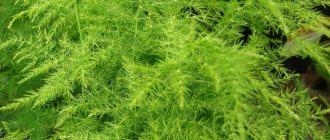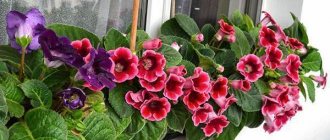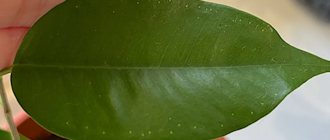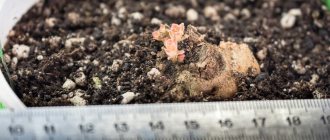Gloxinia did not wake up after wintering
The storage area for gloxinia tubers should be cool and dark. If the gloxinia tuber is mature and healthy, then as soon as you put it in the light and water it little by little, shoots begin to grow. Sometimes gloxinia wakes up on its own, and when you take it out into the light, it already has a shoot. However, in practice it does not always work out as it should.
Gloxinia does not wake up on time due to the fact that the rest period was too short, less than 4 months. It is quite possible that the winter was too dry and the tuber dried out. But in any case, gloxinia wakes up on its own. It just takes patience.
To avoid overdrying of the tuber, pots with gloxinia in winter should sometimes be lightly watered or sprinkled with water. Or you can place gloxinia tubers in plastic bags, adding a little soil or damp moss. Close the bags or seal them tightly. The bag will maintain constant moisture, and due to the fact that the bag is transparent, you will have the opportunity to observe the gloxinia tubers in winter. At the first appearance of leaves, you can immediately plant gloxinia in a pot.
If gloxinia does not wake up after wintering , it means that the gloxinia was sent to wintering too young, which did not have time to form a tuber, or the tuber has rotted.
If a gloxinia tuber was purchased in a store and it did not wake up from hibernation after last year’s flowering, it is possible that the tuber was sold of very low quality. Many gardeners complain about this problem. Outwardly, the tubers look quite safe, but in reality it may turn out that they are already old, or infected with some kind of infection or pests. The strength of such tubers is only enough to bloom for one season.
Dig up the tuber, examine it: if it is very wrinkled, then most likely it is lost. Break or cut it: the tuber should be slightly yellowish or pinkish when cut. If this is the case, then dry the sections, sprinkle with crushed coal, you can treat them with regular brilliant green or fucorcin (raspberry liquid, a strong antiseptic, has an antifungal effect, sold in pharmacies). You can treat the tuber with epin or zircon to increase the vitality of the tuber and stimulate it to form shoots.
If the gloxinia tuber is brown on the cut, then most likely it is gone. If the brown color is only on one edge, cut off all the rot, treat the tuber as described above and plant in new soil.
If you want the purchased tubers to be able to survive the winter without problems, then immediately after purchasing gloxinia tubers at home, treat all planting material in a solution of potassium permanganate or phytosporin. This treatment is aimed at preserving gloxinia tubers from rot.
The next step is to treat the gloxinia tubers with Actellik or Fitoverm. These drugs will help get rid of thrips, spider mites and other pests of indoor plants.
If you purchased gloxinia in a pot, change the soil and treat the tuber. The soil that is sold in pots along with plants is very poor.
Perhaps the tuber is already old and has simply died. Gloxinias live for three to four years. If you really value this particular variety of gloxinia, try to root a cutting or leaf in advance.
Why gloxinias don’t bloom: the buds dry without blooming, fall off or rot
At home, plants with bright, large buds are not easy to grow, with the exception of gloxinia.
This flower is easy to care for, but sometimes it may stop blooming, especially after the winter period. There may be several reasons for this problem; they lie in the conditions of detention.
To find out why gloxinia does not bloom, you need to take a closer look at your specimen and carefully examine its condition.
Why gloxinia does not bloom: the main sources of the problem
Before you worry about the lack of buds in gloxinia, you need to find out about the period and frequency of its flowering. It pleases the eye with flowers from April to August in two stages with a break in early July. To do this, you need to cut off the remains of the buds at the end of the first stage so that it blooms again.
Lush flowering of healthy gloxinia
For your information! Young gloxinia will not bloom until it grows a tuber. If the transplant was in the spring, the first buds will appear by autumn, but may not turn into full-fledged inflorescences. Only after surviving the winter in a pot will gloxinia please the grower, during which time it has become stronger at the root.
If buds do not appear in March, it’s time to wonder why gloxinia does not bloom at home. Among the common reasons why gloxinia buds do not open:
- old age of the flower or damage during transplantation;
- soil or fertilizers are contaminated;
- irregular watering or excess watering;
- the flower was in the shade without light for a long time, it was not taken to a sunny place;
- arid microclimate with high air temperatures, being near heating radiators;
- tuber disease. It will have to be pulled out of the ground and inspected for damage;
- the use of unsuitable fertilizers or violation of the terms of their use;
- the appearance of insect pests, provoked by high humidity and the presence of diseased flowers nearby.
If a gloxinia tuber is damaged, it will spend all its energy on growing the stem and foliage, leaving no energy left for flowering.
Important! Do not transplant the tuber into a pot that is too large. The plant will grow at the root, but the outside will remain frail and dry out.
Why do gloxinia buds dry out without blooming and fall off?
Why doesn't Begonia bloom at home?
Most often, the problem why gloxinia buds dry out without blooming lies in improper care. After all, if they appeared, it means that an obstacle to their further development appeared later.
For example, there is a lack of nutrients, so be sure to feed the flowers in the summer. Buds usually appear at the end of March, and if in winter gloxinia was forgotten somewhere in the shade, a beautiful head of flowers is out of the question.
During hibernation, it should not be left without regular watering and sunlight, as it must gain strength.
You can reanimate flowering using the following scheme of actions:
- Increase the humidity in the room (for example, turn on a humidifier).
- Ventilate the room, avoiding drafts.
- Place the flower on the eastern windowsill.
- Fertilize with phosphorus-potassium fertilizer.
- The soil after watering should be loose and slightly moist.
- Plant in another pot.
The appearance of a gloxinia bud
Dry soil, pests, stale air in the room and low humidity may also be causes. Among fertilizers, preference should be given to phosphorus-potassium fertilizers without nitrogen. It is the gradual correction of these factors that is the answer to gardeners’ worries about what to do if gloxinia’s buds dry out.
Why do the buds turn gray and become soft?
Why does spathiphyllum not bloom at home?
If the flowering is abundant, there may not be enough nutrients to open the buds. It is important to remember that gloxinia itself will not bloom magnificently; it needs feeding.
Pests such as spider mites or thrips may also be involved in softening the buds. To remove them, you need to wash the plant with soapy water, removing the damaged areas. Low humidity and unstable lighting are unacceptable.
Note! If the flower is in a country house or in an unheated house, it cannot be left there until frost.
It is recommended to revive the plant in the following ways:
- daylight hours for gloxinia should be at least 12 hours;
- as soon as the buds appear, a mineral complex of fertilizers with a high content of phosphorus and potassium is needed;
- if watering occurs through a tray, it is better to use two copies. Put gravel in one, expanded clay in the other;
- if gloxinia foliage stretches upward, it does not have enough sunlight;
- If it is impossible to move the flower from a place with an excess of light, you can cover it with gauze or tulle.
To prevent gloxinia from drying out, you can place a container of water next to it. If the plant has little foliage, you need to increase fertilizing with nitrogen fertilizers. This will not contribute to the blooming of gloxinia, but may be useful for the growth of green mass.
Why do buds turn black and rot?
Why Decembrist does not bloom - reasons
High nitrogen content in the soil and excess moisture are the main answers to the question of why gloxinia buds turn black. If you water a flower too often, rot will appear on the tubers and then spread to the above-ground part. Therefore, fertilizers for flowering house plants should always have a low nitrogen content.
Healthy gloxinia buds
It is also easy to explain why gloxinia withers even with the correct use of fertilizers. The answer is simple - it reacts poorly to cold weather and drafts, it is necessary to protect it from temperature changes. Its indicators should not fall below 18-20 °C on the windowsill and below 12 °C in winter if the tubers are stored in a dark place.
If the buds turn black before they bloom, you need to act quickly:
- Treat the tuber with epin. It has an anti-stress effect for plants.
- Make the air more humid; gloxinia should not dry out.
- Keep the plant away from direct sunlight during the day.
- If the soil is old, replace it with new soil.
- Adjust watering, do not water until the top layer of soil begins to dry out.
Important! Young plants overwinter in pots in their usual place; they do not need to be specially prepared for winter.
You can spray indoor gloxinia with regular warm water, but not more than 2 times a week. In this case, moisture should not get on the buds. Excessive use of the procedure will lead to rotting of the leaves and buds.
There are several ways to solve the problem of rotting before blooming:
- limit watering until the top layer of soil is completely dry;
- Water only through the tray, do not spray. Change the water in the pan;
- if the soil is too acidic (due to nitrogen), replant gloxinia with a complete replacement of the soil;
- if these measures do not help, remove and inspect the tuber: cut off the brown spots, coat the cut with activated carbon powder.
Gloxinia tuber needs proper wintering
If rot is found on tubers or foliage, you need to carefully remove the damaged areas and fertilize the plant with suitable products. There is no need to wait for the blackened bud to dry out on its own; you need to trim it yourself.
Why do gloxinia have empty buds?
The main advantage of gloxinia is its charming flowering, which begins in June and lasts until August. That is why the plant is bought during this period to appreciate its beauty.
The more beautiful the flower, the more disappointed the grower will be if the buds turn out to be empty.
If it was blooming when you bought it, and then such a problem occurs, the reason why the gloxinia buds do not bloom lies in improper care.
Repeated flowering of gloxinia is not so lush
You can solve the problem as follows:
- Trim the stalk of an empty bud, otherwise a new one will not appear.
- Fertilize the plant according to plan, wait for the appearance of a new bud.
- After opening a new flower, spray gloxinia with epin according to the instructions.
The plant should be pruned only after it has finished flowering. Also, barren flowers can be a result of too dry air or pest attack. They suck the juices from the leaves and buds, thereby preventing them from opening.
Important! Do not expose gloxinia to drafts or water it with cold water. It is better to put it in bottles and let it sit for several days; this action will help release harmful substances.
How to make gloxinia bloom again
After gloxinia fades, its above-ground part dies off, leaving only the tuber. It is important to properly prepare the plant for winter; two options are acceptable:
- place the dry tuber (previously cleaned of rot) in a pot with soil or river sand. Place in a cool place and moisturize twice a month. Avoid hypothermia;
- put the tuber in a bag with soil and vermiculite in equal proportions, store in the vegetable compartment of the refrigerator.
In February, it is necessary to transplant the tuber into a larger pot. If in April a problem arises as to why the gloxinia buds did not open, the wintering was carried out incorrectly.
After the plant has blossomed and flowered at the end of June, you can prepare it for the reappearance of the flower stalk. To do this you need to follow a simple procedure:
- Trim the foliage, leaving 2-4 lower large leaves.
- Leave a couple of the largest stepsons in the axils of the leaves.
- Feed twice during the period of appearance of stepsons, then fertilize once a month with products for flowering plants.
Important! Repeated flowering is usually not as lush as the first, and this does not mean that the flower is sick. Proper feeding will help the gloxinia buds bloom.
Blooming gloxinia is a real decoration of the windowsill, harmoniously combined with other representatives of the home flora. With improper care, problems begin with the buds, which are successfully solved by carefully correcting errors. After recovery, the flower will delight you with double lush blooms.
Source: https://greensotka.ru/dekorativno-listvennye/pochemu-ne-tsvetet-gloksiniya.html
What to do if gloxinia buds dry out
Why balsam does not bloom at home - the main reasons
Excessively dry air and high temperatures are the most common reasons why gloxinia buds dry out without blooming. So, if the summer is too hot, the plant should be sprayed in a timely manner. In addition, it is recommended to hang a dampened sheet or towel on the windows.
The buds are drying
If there is constant wilting, you can feed with phosphorus-potassium supplements, since these microelements are especially important for the full formation of leaves.
If gloxinia's buds are still drying, and the owner is tormented by the question of what to do about it, attention should be paid to the presence of diseases or the appearance of parasites. Most often, the plant is affected by thrips, nematodes or spider mites.
In case of infection, the plant should be treated with insecticides 2-5 times. If the soil is also contaminated, plant it in another soil for a while. Repeated treatment is carried out after seven days. For prevention purposes, you can use phytosporin or foundationazole.
The following drugs show high effectiveness against most diseases:
- actellik;
- karate;
- phytofarms;
- Actara.
Note! The appearance of light dots, spots or gray streaks on gloxinia leaves signals an infection with thrips. Their occurrence is accompanied by damage to the edges of the buds and further falling off. In this case, the stem dries out and collapses.
Gloxinia did not have time to form a tuber
If gloxinia is grown from seeds, and the seeds are planted late, then the gloxinia may not have time to form a tuber . Gloxinia blooms only at six to seven months of age, when it grows six to seven pairs of leaves. In this case, the young gloxinia does not need to be sent for wintering, because the gloxinia may be completely lost. In winter, try to maintain sufficient humidity and light to prevent gloxinia from stretching out.
To understand whether gloxinia will overwinter or not, count the leaves: if there are only four or five pairs, then such a small gloxinia cannot be sent for the winter. Gloxinia will form buds when it has grown at least six pairs of leaves.
Also, the tuber does not have time to form when growing gloxinia from a leaf or cutting, especially if the cutting is too long and is deeply buried.
Do not overuse watering. Due to waterlogging, gloxinia may also not have time to form a tuber.
Flower maintenance conditions
As we found out above, the main reason why inflorescences die (rot, dry out) is violations in the care of the plant, which then entail the occurrence of a number of diseases and the appearance of pests. Therefore, in this section we will briefly consider the main points of growing gloxinia.
Location. The flower pot must be placed on the windowsills on the east and west sides. During short daylight hours, he is provided with additional lighting.
The optimal temperature for growing the plant is 18-20 degrees. Often in apartments it is a little higher, so the window sill is a good place for flowerpots.
Watering is carried out along the edge of the pot so that water does not get on the flower or through the tray (the pot is placed in water for 15-20 minutes, then the liquid is removed). Water once a week, spray once every three days with warm, soft water.
It is important to properly send the plant to rest. When the flower fades, they stop watering it, and the entire surface part dies. It must be placed in a dry and dark place where the air temperature should be between 10-18 degrees. Tubers can be stored in winter either in pots or placed in river sand. They need to be protected both from drying out and from excess moisture.
It is necessary to take into account the fact that young annual plants are not sent to rest. They spend the winter on the windowsill.
In February, adult tubers are planted in specially prepared soil and placed in a warm and bright place. The pot should be wide, but the depth should be average. The drainage layer is laid down, and then the soil. You can buy it in a store or prepare it yourself. Considering any gloxinia to loose and pH-neutral soil.
These are the key points that novice gardeners should know so that the capricious and demanding plant pleases the eye.
Gloxinia shoots have become very elongated
Gloxinia shoots become very elongated after wintering, when the room is too warm and there is insufficient lighting. Add lighting, periodic air spraying and wet cleaning will help reduce the temperature in the room. Strong stretching of shoots can also occur in insufficient lighting plus overfeeding with nitrogen fertilizers. Add light, do not feed with nitrogen fertilizers.
Gloxinias can elongate due to varietal characteristics; some varieties of gloxinias are prone to elongation of shoots. It is advisable to trim the elongated shoot. The tuber will give a new shoot. The cut shoot can be rooted, and it will also have time to bloom. If an extended shoot is left, it will most likely fall and take root. It will receive nutrition from its newly formed roots, and in addition draw nutrition from the tuber. A new shoot may grow on the tuber, but it will be weak, will not bloom, and the tuber will become weakened and may not survive the winter.
Gloxinia after flowering - what to do with the plant
Experienced owners of green spaces can tell you how to care for gloxinia after flowering. During this period, you need to properly prepare the plant for wintering. This procedure consists of several steps that must be completed so that the tuber safely survives a long hibernation.
Trimming
It is not recommended to trim the rosette immediately after the last flowers have faded. It is necessary to maintain metabolic processes in plant tissues, thanks to which nutrients are transferred from the leaves to the tuber.
Subsequently, the shoots will begin to wither on their own, and then you need to cut off the rosette, but leave a small stump 2 cm high. As a result, when it also dries out, it must be carefully unscrewed from the tuber.
Important! If you prune gloxinia immediately after flowering, this will stimulate shoot growth, which will significantly weaken the plant. In young seedlings, the rosette remains throughout the winter
This is due to the fact that their tubers are not sufficiently developed and are not yet able to survive the winter without additional nutrition. Therefore, it is impossible to cut off the above-ground part of them, otherwise they will never come out of hibernation
In young seedlings, the rosette is maintained throughout the winter. This is due to the fact that their tubers are not sufficiently developed and are not yet able to survive the winter without additional nutrition. Therefore, it is impossible to cut off the above-ground part of them, otherwise they will never come out of hibernation.
In this case, you need to provide the plant with proper care, which consists of a 12-hour daylight hours and regular watering.
Regenerative feeding
What else needs to be done when gloxinia fades? Before the plant goes into hibernation, it is necessary to restore the spent energy. To do this, it is recommended to fertilize with potassium fertilizers. This will allow the tuber to fully ripen and stock up on nutrients that will be needed for 3-4 months of hibernation.
Experienced gardeners recommend using potassium monophosphate for this. To prepare a nutrient solution, you need to dissolve 5 g of the product in 2 liters of settled water. After this, mix thoroughly until the components are completely dissolved. Water the plants with the resulting liquid at the rate of 150 ml per 1 pot.
Important! Fertilizers with a high nitrogen content cannot be used during this period, as they stimulate the growth of the above-ground part, which negatively affects the immunity of gloxinia. Restorative fertilizing is applied once, immediately after removing all faded buds, but in the presence of leaves
Restorative fertilizing is applied once, immediately after removing all faded buds, but in the presence of leaves.
Drying of the rosette is a sign of gloxinia preparing for hibernation
Preparing the plant for hibernation
Caring for gloxinia after flowering at home also involves observing certain maintenance conditions. Starting in September, the flower pot needs to be moved to a less lit place. In this case, the temperature should be lowered to +15 degrees. When kept in such conditions, watering should also be reduced to once a week.
All this together stimulates the process of wilting of the rosette and prepares the plant for the upcoming hibernation.
If this is not done, then some varieties of gloxinia may continue to grow. As a result, the shoots stretch, the rosette becomes deformed, and the plant loses its decorative effect. All this weakens the flower and may cause a lack of flowering next season.
Important! Gloxinia, like many tuberous plants, requires a long cool dormant period to form buds.
Gloxinia leaves have turned yellow
Gloxinia leaves turn yellow when overwatered. If the plant is flooded, it is immediately noticeable by the leaves. It may happen that the tuber begins to rot. Urgently remove the gloxinia tuber, inspect it for rot, treat it with phytosporin or other drugs, and replace the soil.
Gloxinia leaves may turn yellow due to lack of nitrogen. In general, fertilizing with nitrogen-containing fertilizers is recommended only at the beginning of the growing season, when the stem begins to grow. Subsequently, it is better to fertilize with fertilizers in which the content of phosphorus and potassium is much higher than the nitrogen content. Remember that overfeeding with nitrogen can lead to rot of the gloxinia tuber.
Chlorosis of Gloxinia leaves . Chlorosis can be caused by too hard water. Water for watering gloxinias should be settled and warm. Soften it with a drop of vinegar or lemon juice. Chlorosis can be caused by low soil acidity or high ash content. Change the soil.
Spots appeared on gloxinia leaves
Spots on gloxinia leaves may appear from too bright lighting. Shade the gloxinia, otherwise it will get sunburn. Spots on gloxinia leaves can appear from excessive watering, as well as if you water with too cold water. Spotting of gloxinia leaves can be caused by drafts. Small spots on gloxinia leaves may indicate the presence of pests on the plant. Insecticide treatments are needed. In addition, gloxinia can be affected by various viral diseases, for example, tomato ringspot virus.
Gloxinia leaves curl
Curling of gloxinia leaves is possible if the room is too dry and hot. However, even if the air humidity is too high or the soil is excessively waterlogged, gloxinia leaves also curl, bend, short stalks form, or the formation of deformed flowers is observed. Adjust watering of gloxinias. Treat gloxinia with actellik or fitoverm against spider mites. Curling of gloxinia leaves can be caused by an overdose of potassium fertilizers.
Gloxinia does not bloom
Gloxinia does not bloom due to overfeeding with nitrogen fertilizers. Nitrogen only stimulates green growth, but slows down flowering. Delayed flowering may be affected by insufficient lighting, low ambient temperature, low humidity or insufficient watering. Flowering can also be affected by improper or too short wintering, as a result of which the tuber did not have time to prepare for the next season. In order for gloxinia to bloom well next season, it needs a rest period of four months.
For gloxinia to bloom fully, it simply needs good lighting. Gloxinias love light! From the moment they awaken, immediately place pots with gloxinia tubers in places where there is a lot of light, or organize additional lighting, otherwise the buds may not appear at all, and if they do appear, there may be few of them, or the flowers may not be fully formed and may turn out to be empty flowers , or not fully open.
The size of the pot also plays an important role. To grow gloxinia, it is better to choose a small, low and wide pot rather than a deep one. In a large pot, gloxinia will take a long time to grow the tuber to the detriment of flowering. For an adult gloxinia tuber, the pot should be about 9-12 cm in diameter. And after gloxinia begins to actively grow, it is necessary to fertilize with phosphorus-potassium fertilizers.
In addition to the pot, gloxinia annually needs replanting and new fertile soil. You can make the soil mixture for gloxinia yourself: humus, coniferous soil, leaf soil, sand, perlite or hydrogel, peat. But before use, it must be calcined for pests and pathogens. Spread the soil on a tray and bake it in the oven for 20-30 minutes.
If it is not possible to make your own soil mixture, then you will have to use a store-bought mixture, but fertilize more often.
Why do the buds dry out?
One of the reasons why buds dry out is lighting. Too much light is bad, too little is also a disaster. Therefore, when choosing a place for a pot with gloxinia, it is necessary to take this feature into account and position the plant so that the lighting level is optimal. Then the flowering will be abundant and bright.
Also among the reasons that can lead to gloxinia buds drying up without blooming are:
- excessive soil and air moisture;
- cold;
- high temperature in the room;
- stale air;
- drafts;
- excessive or insufficient feeding;
- dry air.
As you can see, there are a large number of factors on which the duration and abundance of flowering depends. And when a problem is identified, it is worth considering all of them in order to provide timely assistance to the flower and not lose it.
Watering the plant is the next point that needs to be paid attention to. If it is carried out incorrectly, the buds do not open, the leaves die, and the root system suffers.
Proper watering is important for gloxinia. Water must flow to the roots through the soil, so it is carefully poured over the edge of the pot so as not to flood the rosette. Excess water is removed from the pan so that the roots do not begin to rot. During cold weather, watering can be reduced to spraying, but it is necessary to monitor the condition of the soil and prevent it from drying out, understanding that for normal growth the plant needs moderate moisture. For watering and spraying, only settled water at room temperature is used.
Gloxinia requires special attention during the heating season. At this time, the air in the room is quite dry; under such conditions, the buds rarely open. It is recommended to periodically spray the flower, however, in this matter one should adhere to the “golden mean”. Excessiveness harms the plant.
These are the main points of care, the violation of which can disrupt the proper growth and flowering of gloxinia. But besides them, you should understand that if the temperature is too low and in drafts, gloxinia buds also wither and fall off.
Now about feeding. The lack of nutrients in the soil does not allow the plant to gain strength and fully realize itself: to form flower stalks and bloom. If the buds turn black and then begin to dry out, then this is a sure sign that the soil has a low amount of microelements. This means that the indoor flower needs feeding. Phosphorus-potassium fertilizers are best suited for these purposes.
Peduncles also dry out when gloxinia is damaged by pests of indoor plants such as:
- spider mite;
- thrips.
If they are detected, the flower should be immediately treated with insecticides.
The petioles of gloxinia leaves rot, the buds rot, turn black and die
In gloxinia, leaf petioles rot, buds rot due to excessive waterlogging, too acidic soil pH, as well as excessive amounts of nitrogen-containing fertilizers. Change the soil, adjust the watering. To avoid overdoing it with nitrogen, use only complex fertilizers that contain phosphorus and potassium in addition to nitrogen. Additionally, carry out two or three treatments with phytosporin, Maxim or another fungicide to preserve the gloxinia tuber from rotting.
If gloxinia's buds turn black and die , then most likely the winter was too cold, the soil is too poor and there is not enough nutrition, or there is severe overwatering. Typically, problems with flowering are solved by fertilizing with phosphorus fertilizers and additional lighting. Treat with fungicides. If the problem is not corrected, then most likely there is a problem with the tuber: it has begun to disappear.
Gloxinia produces a barren flower
First, on the gloxinia , as usual, the sepals open, and inside, instead of a bud, there is a green pea, a barren flower . After some time, the peduncle on which this underdeveloped bud grew turns brown.
Perhaps the gloxinia tuber was stored at too cold a temperature. Cut this peduncle and wait for the next peduncles. After a while, watch how new buds open, perhaps everything will return to normal without additional intervention. Try a few more sprays with Epine to help the plant relieve stress and help the formation of normal buds.
Gloxinia's buds do not fully open
Gloxinia's buds do not fully open , and then turn brown and become soft. This is quite possible, if gloxinia has too many buds and does not have enough fertilizing, it is simply not able to cope with flowering. In this way, gloxinia itself regulates its flowering. This may be a varietal feature.
It is possible that it bloomed too early or late, when the daylight hours are short and there is simply not enough light for it. Typically, this occurs during the off-season.
Under-opening of buds may result from an attack by spider mites or thrips. Treat with insecticides.
How to help gloxinia
Help will depend on the problem itself.
Gloxinia buds are drying
Gloxinia's buds dry out for many reasons, and the grower needs to be prepared for an emergency review of agricultural technology to save the flower. The most common reason why buds dry out is a deviation from the normal lighting level. Gloxinia will not bloom whether due to excess or lack of sunlight.
In addition to the lighting indicator, it is necessary to check the air condition in the room with gloxinia and the quality of the soil in the pot. Drying of buds is caused by cold, damp or dry air, drafts, flooded or depleted soil.
Priority measures: Check lighting, temperature and humidity, block drafts, check the soil, replant or fertilize the plant.
Unopened buds fall off
Abundantly flowering gloxinia can drop its buds if the weather is too hot. Dry and hot air encourages the plant to restrain the intensity of flowering by shedding formed buds.
Priority measures: Organize ventilation, eliminating drafts, shade the plant from the midday sun. You should place a container of water next to the flowerpot to increase air humidity.
Buds do not open
Gloxinia's buds do not open for several reasons. The plant produces buds, but cannot flower if there is too little or too much lighting, incorrect fertilizing or depletion of the soil. Pest invasion depletes the plant and blocks the opening of buds. Thrips and spider mites pose a threat to indoor beauty.
Priority measures: The first step in saving gloxinia is to adjust the lighting regime. The plant should be shaded from direct sunlight if there is an excess of light. The lack of lighting is compensated by moving the flowerpot to another window sill. If this is not possible, artificial lighting is provided.
Gloxinia needs to be replanted every spring to avoid soil depletion.
Incorrect application of fertilizing disrupts the natural growing season of the plant. Beginning flower growers are often confused about when and what fertilizers are required for gloxinias.
Nitrogen fertilizers are applied during the period of green mass growth. You should switch to a potassium-phosphorus mineral complex with the formation of the first buds. In the fight against flower pests, treating plants with insecticides will be an invaluable salvation. Remedies for thrips and spider mites are sold in specialized retail outlets. It is important to carefully study the instructions on the packaging and adhere to safety precautions.
Barren flower instead of flower
Sometimes you can observe how the buds of gloxinias without leaves open. The blossoming sepal reveals a small pea. Soon the peduncle turns brown and the bud falls off. The cause of this symptom is a cold winter; the plant has not recovered from winter stress.
Priority measures: the defective bud should be carefully removed along with the peduncle. After some time, the indoor plant will throw out a new bud. In most cases, gloxinia should open full flowers.
It is recommended to treat the specimen with the anti-stress drug Epin. The procedure must be carried out according to the instructions on the package. Soon gloxinia will respond to care with the beauty of blooming flower stalks.
Gloxinia buds rot
Inexperienced flower growers often watch the buds rot. Dry black flower buds should not be confused with rotting ones. In both cases, gloxinia buds do not bloom. When rotting, the bud remains soft and moist. Its color changes to brown, dark brown, black. A detrimental reason for the plant is deviation from the temperature regime and excessive watering. Improper wintering exposes the plant to stress. Gloxinia loses its resistance to rot; excessive watering leads to rotting of the buds.
Priority measures: Watering gloxinia should be carried out exclusively through a tray. Watering is limited for several days to allow the substrate to dry out. You cannot go to the other extreme and allow the earthen clod to dry out. The soil should remain loose and slightly moist.
It is useful to treat the specimen with the anti-stress drug "Epin", which will help gloxinia recover from stress and correctly enter the flowering phase. If the measures taken do not have a positive result, then the problem lies in the tuber.
It is possible that the cold winter caused the tuber to rot.
In this case, you need to carefully examine the tuber. Brown spots are cut off with a sharp knife to healthy tissue. The cut is disinfected with crushed activated charcoal or charcoal. The tuber is planted in a new pot using calcined drainage and a new soil mixture.
No flowering
Flowering is a natural vegetative phase of gloxinia development. Gross violations of the plant's rules of agricultural technology can lead to a lack of flowering as such. Tuberous plants do not form pedicels with buds until they have mastered the entire substrate. Beginning gardeners often plant plants in pots “to grow,” thereby depriving themselves of the pleasure of admiring the bright blooms of gloxinia.
The second, most common reason for the lack of flowers is the incorrect composition of the soil. A large amount of nitrogen leads to vigorous growth of green leaves. Ready-made substrate for violets is perfect for gloxinias. You should also carefully study the fertilizing calendar.
Priority measures: The soil should be replaced with store-bought soil that optimally meets the requirements of gloxinia. A careful study of the composition of the mineral fertilizer complex will help you avoid mistakes.
The complex with a predominance of nitrogen is intended for feeding in the spring, after gloxinia awakens after hibernation. The fertilizer is changed after a sufficient number of leaves have grown. Gloxinia requires a potassium-phosphorus complex to enter the next phase of development. Potassium and phosphorus predominate in these fertilizers, nitrogen is contained in minimal quantities.
Gloxinia grown in a large pot must be transplanted into a container of optimal size.
These indoor plants need low pots with a diameter of 8-12 centimeters. Replanting needs to be done every spring.
Gloxinia buds turn black
Sometimes gloxinia buds wither without blooming. Dried sepals fall off the peduncles. These symptoms are very similar to rotting, with the difference that the black buds are dry. The most common causes of these symptoms are overwintering the tubers in a cold room, dry air, poor soil, too frequent watering, and dry soil.
Priority measures: Place a container of water next to the gloxinia to maintain optimal humidity levels. You can use the two-pallet method with a small window sill. The lower, deeper pan is filled with fine gravel, expanded clay and filled with water. The second pallet with a flowerpot is placed on gravel. In hot weather, the plant is shaded so as not to expose it to stress from direct sunlight.
The error of incorrect wintering is corrected by examining the gloxinia tuber, followed by treatment with an anti-stress drug. Poor soil is replaced with fresh substrate. Overflow is corrected by observing intervals between waterings so that the soil has time to dry out. Drying out of the soil can be avoided using hydrogel.
All the leaves of Gloxinia began to wither
If gloxinia's leaves begin to wither in the fall, this means that gloxinia is preparing for winter. Reduce watering to a minimum. Wait until the gloxinia has completely withered, cut off the upper part of the shoots, leave only a small stump and send the gloxinia tuber for the winter. It can be in the same pot, or it can be in a plastic bag, as described in problem 1.
If gloxinia’s leaves begin to wither during the growing season, then most likely there is a problem with the tuber. It rotted from too much waterlogging. Dig up immediately, cut off the affected leaves, treat the tuber with fungicides and plant in fresh soil.
Causes of spoiling buds in Gloxanias
Gloxinia is a beautiful indoor plant that pleases the eye with its decorative greenery and bright, exquisitely shaped flowers.
The homeland of this exotic beauty is Brazil. But today it has successfully undergone acclimatization and is perfectly grown by gardeners at home. However, it should be noted that gloxinia is a rather demanding plant. It needs proper care and daily attention from the grower, and then the exquisite flower will delight you with its shapes and colors.
When starting to grow gloxinia, everyone, both experienced and just beginning gardeners, should have a clear idea of what kind of care the flower needs, as well as what problems it may encounter and how to prevent them.
The pretentiousness of the plant requires strict adherence to all the rules of growing at home; any violation can lead to the flower starting to hurt, its leaves turning yellow and withering, and the buds drying out, turning black, and rotting without any bright colors.
Light-loving gloxinia, with a sufficient amount of bright light, has a juicy green leaf color and a well-formed rosette. If there is too much sun and its rays are burning, then the plant will begin to fade, the leaves will lose their juiciness and droop, the unopened buds will begin to dry out and their number will noticeably decrease. Also, the health and appearance of the flower directly depends on proper watering, timely feeding, temperature conditions and other factors. Let's look at them in more detail.
How to make gloxinia bloom again
If your gloxinia has bloomed and no longer forms flower stalks, and you want to force the gloxinia to bloom again , cut it back to 2-3 pairs of leaves. In 1.5-2 months, the gloxinia will grow a new stem, and your favorite gloxinia will bloom again. Repeat flowering can be stimulated by fertilizing with phosphorus-potassium fertilizers.
The rights to the images belong to myhome-flowers.ru, dimetris.com.ua, forum.prihoz.ru: Sweet Berry, flickr.com: smalla, CameliaTWU, philipbouchard, Meighan, Larra Jungle Princess, carolinesoer, kasmil, Gerbera2009, ??? ??, livingflame, Sirelroka
Care after flowering
Flowering time can be significantly extended with proper care . Many varieties and types of synningia have a tendency to bloom again, especially if the first one was early. Usually it is not so lush and abundant, and the flowers are much smaller.
After flowering, gloxinia should be carefully examined for the presence of a growing point on the stem. If there is one, in a month the plant will produce new flowers.
Trimming
pruning may be necessary to stimulate re-blooming . In this case, the above-ground part (leaves and stem; 2-4 lower leaves may not be removed) is cut off and a shoot about 2 cm long is left. Soon after this, the second growth of gloxinia occurs: side shoots appear.
It is not at all necessary to leave all the side shoots , one or two of the strongest will be enough - the rest are cut off so as not to weaken the plant. After a month, new buds begin to develop on them.
During the period of bud set, synningia must be fed with fertilizer

